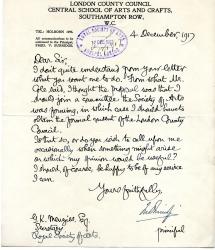
One Signed Letter, in the hand of a secretary, four Typed Letter Signed and two Typed Notes Signed (all seven 'Fred Burridge') to G. K. Menzies, Secretary, Royal Society of Arts.
All seven items 4to, 1 p. Each docketed and bearing the stamp of the Royal Society of Arts. All good, on lightly-aged paper. The first is in a secretarial hand, with the other six all typed. Item One: 4 December 1917. He doesn't 'quite understand' from Menzies' letter what it is that he wants him to do. 'From what Mr. Cole said, I thought the proposal was that I should join a committee the Society of Arts was forming, in which case I should have to obtain the formal consent of the London County Council.' Wonders whether on the other hand Menzies might 'wish to call upon me occasionally when something might arise on which my opinion would be useful?' Item Two: 16 January 1918. A note in which Burridge agrees to serve on the Applied Art Prizes Committee. Item Three: 22 March 1918. Providing a list of the fifteen 'best Local Educational Authorities to write to', beginning with 'Edinburgh (General Handicrafts) | Glasgow (Carpets & General Manufacture)' and ending with 'Stourbridge (glass)'. Each entry has been assigned in a pencil annotation to either the 'School Board', 'Technical Instruction C'tee' or 'Education C'tee'. Further annotated on the reverse (presumably by Menzies) with fifteen names and addresses, beginning with 'J. Stewart, School B'd Offices, Castle Terrace Edinburgh' and ending with 'W. M. Robins, Technical School, Stourbridge'. Item Four: 25 June 1918. Headed 'Silver Cup'. Regarding the design of the cup, Burridge notes that 'Wilson as a member of the Committee is to be considered as out of the running.' Burridge does not agree with Menzies' view that 'in present circumstances Ramsden and Carr are the best people to go to, because although Mr. Ramsden would no doubt give you an excellent design, the work in the main would be carried out probably by a young student of mine who has only been with him some eighteen months, and is therefore not in my opinion sufficiently a master of his craft to be entrusted with such a work'. Burridge's suggestion is 'that the commission be given to Mr. Charles Welch of 24, Asmun's Hill, Hampstead Way, Hendon, N.W.4., and in my opinion perhaps the most skilful silversmith in the country.' Welch is also 'a good designer and therefore could be trusted to produce you an article of sterling merit'. Postscript: 'Since writing this I have seen Troup and he concurs'. Item Five: He is writing 'to confirm my request in our conversation over the telephone this morning that you will please destroy my letter of the 25th instant [i.e. Item Five], which I wish to withdraw, as I have now no recommendation to make and will have nothing to do with the selection of a silversmith to do the work proposed'. Item Six: 7 March 1919. A note of two sentences: 'Thanks for yours of the 4th instant. I quite agree.' Item Seven: 22 October 1919. Note of one sentence: 'As promised in my telephone conversation this morning, I return the Redsull paper herewith.'


